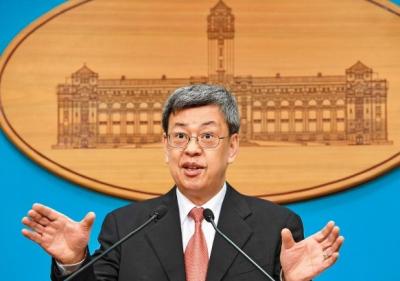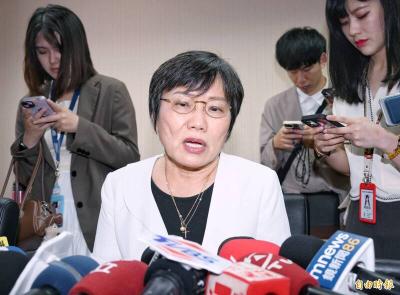The latest US report on the imbalance in military capabilities across the Taiwan Strait raises further questions about President Ma Ying-jeou’s (馬英九) determination to defend Taiwan and his capability as commander-in-chief, Democratic Progressive Party (DPP) lawmakers said yesterday.
A US Department of Defense report released on Monday, titled Military and Security Developments Involving the People’s Republic of China, briefly criticized Taiwan’s defense spending, which is now approximately 2 percent of GDP — below Ma’s pledge of 3 percent, and its transition to voluntary military service.
The legislators told a press conference that Ma “has mistakenly claimed that cross-strait relations are at their best in six decades,” adding that this was the basis for the weakened foreign and defense policy.

Photo: CNA
DPP Legislator Chen Ting-fei (陳亭妃) said the ratio of conscripted soldiers and voluntary soldiers was 47.5 to 52.5 in 2007 when the DPP was in power, but the ratio has dropped dramatically since then and is now 37 to 63.
“While Ma pledged the implementation of a volunteer system, the ratio has not improved since he took office,” Chen said.
Ma was diverting funds from weapons acquisition programs and using them for salaries and benefits, adding that military investment accounted for 35.94 percent of the total defense budget in 2008, a ratio that has dropped to 25.89 percent this year, she said.
“We support a volunteer military, but it is absolutely wrong to divert the weapon procurement budget to personnel salaries,” she said.
The Ministry of National Defense yesterday responded to the US report, saying it could not afford to reduce its vigilance.
Ministry spokesman Major General David Lo (羅紹和) said that despite eased cross-strait tensions, it was evident that China had not abandoned the idea of invading Taiwan and had continued to modernize its military and to deploy missiles.
In face of China’s growing clout and increasing military budget, the military needs to strengthen itself to maintain continued peace in the Taiwan Strait, Lo said. The military must be practical and establish an elite armed force that, while reduced in size, loses none of its potency and ability, he said
In essence, the military needed to give an enemy sufficient reason to be wary of hostile intentions though innovative and asymmetric strategies, Lo said.
He said the ministry was aware of the nation’s tightened finances and had sought to reduce its expenditures. Within reasonable budget limitations, continued investment in military technology is expected, Lo said.
The change from conscription to a voluntary service is a major transition for the military, and in the short term, the proportion of the military’s budget for personnel would increase to help facilitate the changeover, Lo said.

Taiwan would welcome the return of Honduras as a diplomatic ally if its next president decides to make such a move, Minister of Foreign Affairs Lin Chia-lung (林佳龍) said yesterday. “Of course, we would welcome Honduras if they want to restore diplomatic ties with Taiwan after their elections,” Lin said at a meeting of the legislature’s Foreign Affairs and National Defense Committee, when asked to comment on statements made by two of the three Honduran presidential candidates during the presidential campaign in the Central American country. Taiwan is paying close attention to the region as a whole in the wake of a

President William Lai (賴清德) has appointed former vice president Chen Chien-jen (陳建仁) to attend the late Pope Francis’ funeral at the Vatican City on Saturday on his behalf, the Ministry of Foreign Affairs said today. The Holy See announced Francis’ funeral would take place on Saturday at 10am in St Peter’s Square. The ministry expressed condolences over Francis’ passing and said that Chen would represent Taiwan at the funeral and offer condolences in person. Taiwan and the Vatican have a long-standing and close diplomatic relationship, the ministry said. Both sides agreed to have Chen represent Taiwan at the funeral, given his Catholic identity and

Chinese Nationalist Party (KMT) Chairman Eric Chu (朱立倫), spokeswoman Yang Chih-yu (楊智伃) and Legislator Hsieh Lung-chieh (謝龍介) would be summoned by police for questioning for leading an illegal assembly on Thursday evening last week, Minister of the Interior Liu Shyh-fang (劉世芳) said today. The three KMT officials led an assembly outside the Taipei City Prosecutors’ Office, a restricted area where public assembly is not allowed, protesting the questioning of several KMT staff and searches of KMT headquarters and offices in a recall petition forgery case. Chu, Yang and Hsieh are all suspected of contravening the Assembly and Parade Act (集會遊行法) by holding

Lawmakers from the Democratic Progressive Party (DPP) yesterday established a friendship group with their counterparts in Ukraine to promote parliamentary exchanges between the two countries. A ceremony in Taipei for the Taiwan-Ukraine Parliamentary Friendship Association, initiated by DPP Legislator Chen Kuan-ting (陳冠廷), was attended by lawmakers and officials, including Deputy Minister of Foreign Affairs Francois Wu (吳志中) and European Economic and Trade Office in Taiwan Director Lutz Gullner. The increasingly dire situation in Ukraine is a global concern, and Taiwan cannot turn its back when the latter is in need of help, as the two countries share many common values and interests,